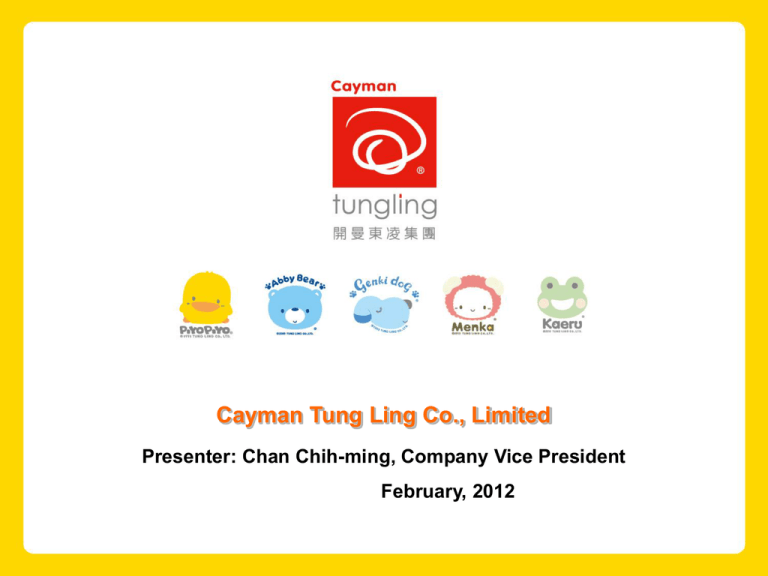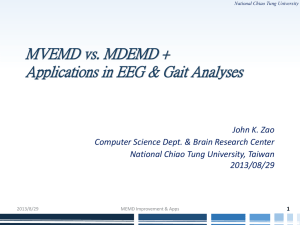Marketing Strategy
advertisement

Cayman Tung Ling Co., Limited Presenter: Chan Chih-ming, Company Vice President February, 2012 1 Presentation Highlights 1. Company profile 2. Product lineup 3. Market overview 4. Sales scoreboard 5. Operations summary 6. Marketing Strategy 7. Milestones in IP & trademarks 8. Company strengths & market positioning 9. Short-term outlook splendid, long-term business roadmap on track 2 Company profile History Year Cayman Tung Ling Timeline 1988 Tung Ling Industrial Co. Ltd was established in Taipei, Taiwan. 1991 The “Piyo Piyo” trademark application was filed. 1994 Businesses diversified from gift and stationary market to children’s outerwear/clothing and other kids’ products. 2000 The “Abby Bear” trademark application was filed. 2002 Shanghai Tai Ling Baby Product Co. Ltd was established in Shanghai, China. 2002 First Piyo Piyo Fun House booth was opened in New World department store in Shanghai, China. 2003 The “Genki Dog” trademark application was filed. 2005 Number of direct-owned retail stores/booths reached over 100. 2007 Shanghai Piyo Piyo Trading Co. was established to focus on retail channels. 3 Company profile History (continued…) Year Cayman Tung Ling Timeline 2008 A logistics center was established in Kunshan, China. 2008 Number of direct-owned retail stores/booths reached over 200. 2009 Cayman Tung Ling Corp. was established. 2010 America Tung Ling Corp. was established in Irvine, CA, USA. 2010 Certified by ST Toy Association and rated “Premier Manufacture”. 2010 The “Menka” and “Kaeru” trademark applications were filed. 2011 The “Piyo Piyo” brand was awarded as a “Shanghai Famous Brand”. 4 Company profile History (continued…) Year 2011 2011 2011 Cayman Tung Ling Timeline The company was awarded as a “Taiwan’s Renowned Brand”. The company made its OTC IPO debut in December 2011, with paid-in capital of NT$302.37mn. Number of direct-owned retail stores/booths reached over 300 in China. 5 Company profile Introduction 1. Date of incorporation: February 6, 2009 2. Place of incorporation: Cayman Islands 3. Paid-in capital registered with OTC market: NT$302.37mn 4. Workforce worldwide as of December 31, 2011: A total of 937 employees, with 84 in Taiwan, 828 in China, and 25 in the US 5. Chairman: Pao-hsia Lin 6. General manager: Fu-chin Hsu 6 Company profile Corporation Structure As of December 31, 2011 Cayman Tung Ling Co., Ltd. 100% 100% 100% Tung Ling Industrial Co., Ltd. (Taiwan) 100% Shanghai Tai Ling Baby Product Co. Piyo Piyo International Ltd. (Hong Kong) America Tung Ling Corporation (USA) 100% Shanghai Piyo Piyo Trading Co. 7 Product lineup Highlights 1. We are principally engaged in the marketing and production of a broad range of “PIYO PIYO” branded children’s outerwear/clothing and accessories. 2. Our infant and toddler mix spans organic cotton apparel and underwear specifically designed for 0~4 year-old children. 3. Our mother-care and nursing categories includes series of products for 0~6 year-old children. 8 Product lineup Primary product categories 9 Product lineup We have been shifting our product portfolio toward pre-school and school-age children from the existing focus on infants and toddlers. Baby Accessories Kids Accessories Children Accessories 10 Market overview Nationwide urbanization and the rise of the middle class heat up China’s consumer market • China’s urban population as a percent of total population topped 50% and leapt 1.32ppts (21mn) to 51.27% (69.08mn) last year, according to NBSC’s 2011data. These figures present a significant upside potential in China’s urban population compared to an average of 85% in advanced counterparts. • CASS’ projections show that a 1% annual urbanization rate will translate into an addition of over 10mn urban residents a year, which could in turn lift consumer spending by 1.6%. A clear uptrend in China’s urbanization will continue to catalyze the consumer market going forward. The population of Chines e Rural and Urban area in three decades Urban 9.0 Rural Unit: 100M 8.0 7.0 7.2(52%) 8(82%) 6.0 6.7(48%) 5.0 4.0 3.0 1.9(18%) 2.0 1.0 0.0 '80 Source: CASS '85 '90 '95 '00 '05 '09 '13 '15 11 Market overview An upturn in PCDI boosts China’s domestic demand China’s 2011 urban PCDI was RMB21,810,up RMB2,710 or 14.1% YoY and YoY expansion excluding price factors was 8.4%, based on NBSC’s data. YoY change in Chinese 2007-2011 urban PCDI Urban PCDI growth rate(%) RMB 25,000 20,000 15,000 10,000 5,000 0 13,786 15,781 12.2 8.4 2007 2008 17,175 9.8 2009 19,109 7.8 2010 % 24 21 18 15 12 8.4 9 6 3 0 21,810 2011 12 Market overview China’s consumer market boom in focus NBSC’s data indicate that China’s 2011 retail trade soared 17.1% YoY to RMB18.1tn. YoY change in China’s 2007-2011 retail trades China's retail trade growth rate(%) RMB 100M 181,226 200,000 154,554 160,000 120,000 80,000 89,210 108,488 125,343 21.6 16.8 15.5 % 40 30 18.4 17.1 20 10 40,000 0 0 2007 2008 2009 2010 2011 13 Market overview Baby and Children’s apparel and accessories market in China China’s kids apparel market is forecast to expand at a 12.6% CAGR to RMB140bn in 2015 from 2010’s RMB77.6bn. China’s kids accessories market is projected to pace a 8.69% CAGR to RBM219.5bn in 2015 from RMB141bn in 2010. Source: CASS 14 Market overview Baby and Children’s apparel and accessories markets in China Clothing/outerwear, baby bedding products, toys, and nursery accessories are categorized as baby care supplies and nursery items in China. Average household expenditure on baby and children’s products is projected to accelerate from RMB5,095 in 2010 to RBM7,914 in 2013, with an estimated 14.52% CAGR. Source: Frost & Sullivan 15 Sales scoreboard Summarized income statements FY08 FY09 FY10 1-3Q11 (unit:NT$1k) 569,307 774,443 954,489 794,873 Gross profit(unit:NT$1k) 204,067 391,021 540,154 441,853 36% 50% 57% 56% 47,181 106,943 174,823 98,416 44,385 101,361 170,316 101,300 33,594 64,634 125,157 65,519 Sales Gross margin (%) Operating profit Pre-tax profit Net profit (unit:NT$1k) (unit:NT$1k) (unit:NT$1k) Note: 1. 2. Disclosure of FY08-10 statements was prepared based on a compilation of pro forma financial information. 1-3Q11 statements were reports based on reviewed consolidated financial information. The pro forma financial statements included the consolidated balance sheets of subsidiaries in China and Taiwan (the “Group”). 16 Operations summary Sales breakdown by region 100% 90% 80% 70% 60% 50% 40% 30% 20% 10% 0% 2009年 2010年 2011年 Others 4% 3% 3% USA 0% 0% 2% Taiwan 17% 20% 20% China 79% 77% 75% Note: Others include Hong Kong, India, Indonesia, Malaysia, Singapore, and other Asian countries. 17 Operations summary Sales breakdown by product category Baby care supplies, nursery accessories 48% 2010 Baby care supplies, 年 nursery accessories 46% 2009 年 Children’s cotton apparel/outerwear 54% Baby care supplies, nursery accessories 45% Children’s cotton apparel/outerwear 52% 2011 年 Children’s cotton apparel/outerwear 55% 18 Operations summary YoY changes in FY09-11 sales Sales NT$1K 1,400,000 1,200,000 1,000,000 800,000 600,000 400,000 200,000 0 36.03 774,443 2009 growth rate(%) 954,489 23.25 2010 % 40 1,116,419 35 30 25 16.97 20 15 10 5 0 2011 Note: FY09-10 results were reported based on audited pro forma financial statements. FY11 statements disclosed unaudited financial information. 19 Operations summary YoY change in net income Unit:NT$1K 140,000 125,157 120,000 100,000 80,000 65,519 64,634 60,000 40,000 20,000 0 2009 2010 1~3Q, 2011 Note: FY09-10 net incomes were reported based on audited pro forma financial statements. 1-3Q11 statements disclosed reviewed financial information 20 Marketing Strategy Network of operations in China Headquarters in Shanghai Logistics center in Kunshan 8 offices for regional operations 220 direct-owned stores/booths in 40 cities nationwide 84 wholesaler-owned stores/booths 195 kids clothing and accessories shops and chains approximately 1,000 sales channels in China 21 Marketing Strategy Business Development Strategy in China Target Strategy Major Cities Sales Dept.- Retail, Central Eastern Region Division Sales Dept.- Retail , Non Central Eastern Region Division Central eastern region: Directowned retail stores/booths Non central eastern region: Direct-owned retail stores/booths Department stores Shanghai, Dalian, Hangzhou, Suzhou, Wuxi, Ningbo, Nanjing, Changzhou, Jinhua, Lishui, Hefei, etc. Sales Dept.Wholesale Wholesalers(2nd and 3rd tier cities) Department stores Department stores, baby clothing and accessories shops and chains Beijing, Tianjin, Chongqing, Chengdu, Guiyang, Guangzhou, Shenzhen, Xiamen, Fuzhou, Wuhan, Kunming, etc. Three Northeast provinces (Jilin, Liaoning, and Heilongjiang), Inner Mongolia, Xinjiang province, Qinghai province, and others 22 Marketing Strategy Highlights of the China business expansion strategy 2012 market expansion plans 1. Store expansion strategy by end of 2012: Targeting the addition of 40~50 kids clothing and accessories stores in department stores and shopping malls 2. Tightening grip on IP rights including copyrights, trademarks, industrial design rights: Apply “Shanghai Famous Trademark” in 2012 to increase brand value and protect intellectual property rights of the company 3. Widening dimensions of “PIYO PIYO” brand product mix breadth: Extending the reach into the older, school-age children’s market 4. Stepping up expansion of baby care supply, nursery accessory chain stores: 5. Adding outlets in second- and third-tier cities Diversifying into higher-end and wholesales markets to create new sales and earnings streams 23 Marketing Strategy Network of Taiwan’s operations Sales breakdown by segment: contracted distribution 64%, DOS 24%, and international trade 12% 1. Distributor Channels: mostly pharmacies, chain drug stores and large-sized baby care supplies, nursery accessories stores 2. DOS: the number of its Direct-owned retail stores/booths totaled 14 including 8 stand-alone stores and 6 shops in department stores as of December 31, 2011 3. International trade: sales in Hong Kong, Singapore, Malaysia, India, Indonesia, and other markets in Southeastern Asia 24 Marketing Strategy Network of operations in US Office of US operations: 14150 Myford Rd. Irvine, CA, 92606 Target market: west coast cities with large Asian populations DOS: 6 direct-owned retail stores Contracted distributor/retailers: large-sized baby care and drug stores/pharmacies including CVS and Walgreens Online retailers like Amazon 25 Milestones in IP & trademarks IP Scoreboard Nation Design patents Taiwan 16 China 15 Germany 1 US 1 Total 33 Nation Trademarks Nation Trademarks Taiwan 272 South Korea 7 China 156 Japan 3 Singapore 24 India 11 Hong Kong 19 Thailand 12 US 13 Malaysia 3 Indonesia 11 Eurozone 1 Total: 532 26 Milestones in branding & trademarks Commitment to R&D programs and innovation in product designs 1. R&D guiding principles Trendiness, modernization, and safety 2. Near-term R&D focus Adding a product lineup of educational toys and learning toys for children aged 0~6 Diversifying mix into indoor toys for kids aged 7~13 27 Company strengths & market positioning Building core competencies and brand values by offering products characterized by pleasant aesthetics and human touch designs Strive for continuous improvement in innovation of products and molding design to set our products far apart from typical products with boring designs Providing a broad spectrum of products targeting a myriad of market segments and satisfying clients’ various demands 28 Short-term outlook splendid, long-term business roadmap on track Short-term plans Widen dimensions of brand product mix breadth Extend its reach into the older school-age children market segment Deepening distribution channel penetration in China’s third and fourthtier cities and building footprint in the US online and physical retail markets Medium-and long-term plans Cross-industry cooperation plans like participation in cartoon motion picture production aiming to boost sales of cartoon character products Shifting its brand licensing strategy to products outside of its existing focus on children’s clothing and accessories to create new revenue streams Active involvement in internal trade shows and exhibitions to extend channel distribution footprint in new markets 29 30









